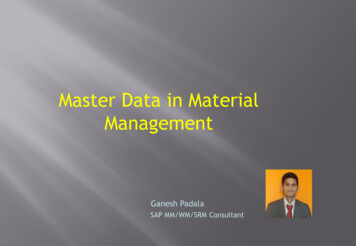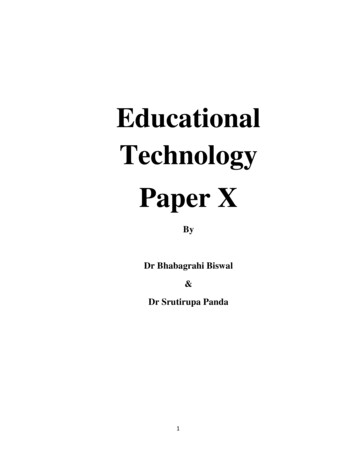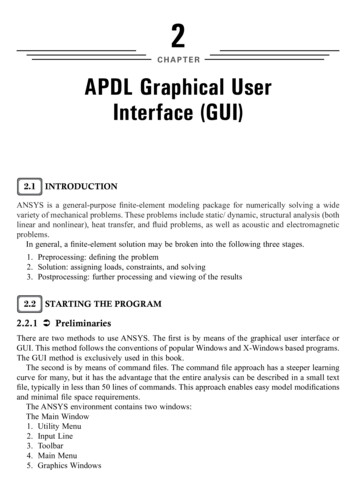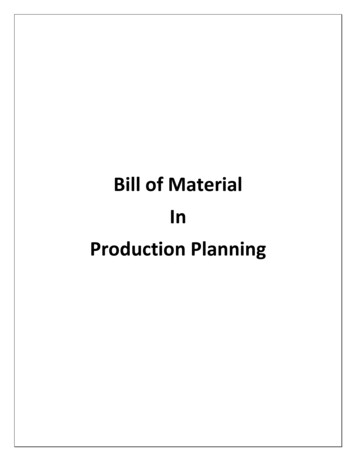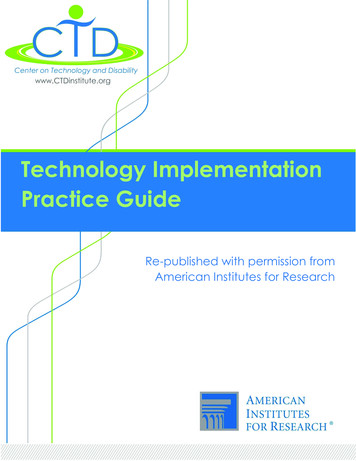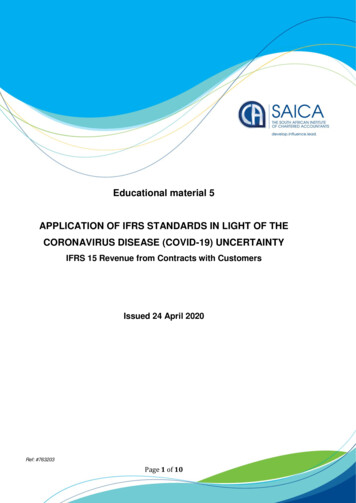
Transcription
Educational material 5APPLICATION OF IFRS STANDARDS IN LIGHT OF THECORONAVIRUS DISEASE (COVID-19) UNCERTAINTYIFRS 15 Revenue from Contracts with CustomersIssued 24 April 2020Ref: #763203Page 1 of 10
Contents1. Introduction . 32. Variable consideration . 33. Contract modifications . 74. Other considerations in terms of IFRS 15 . 9DisclaimerPlease note that every effort has been made to ensure that the advice given in this educationalmaterial is correct. Nevertheless, that advice is given purely as guidance to members of SAICAto assist them with particular problems relating to the subject matter of the educational material,and SAICA will have no responsibility to any person for any claim of any nature whatsoever thatmay arise out of, or relate to, the contents of this educational material.Page 2 of 10
1.IntroductionThis educational material issued by SAICA’s Accounting Practices Committee (APC) isprepared for educational purposes, highlighting the requirements within IFRS that arerelevant for entities considering how the pandemic affects their accounting, for financialperiods ending on or after 31 December 2019 with a specific focus on IFRS 15 - Revenuefrom Contracts with Customers.Entities are reminded to consider the impact of events related to COVID-19 on bothinterim and annual financial statements.This guidance does not change, remove nor add to, the requirements in IFRS. It isintended to support the sound, consistent and robust application of requirements inIFRS. It is of importance that IFRS is applied consistently on the basis of the most robustreasonable and supportable assumptions in the current environment.2.Revenue from contracts with customers – Application of IFRS 15This educational material sets out the financial reporting considerations arising fromCOVID-19 for revenue measurement due to the impact of the existence of variableconsideration in a contract with a customer, contract modifications and other IFRS 15considerations.2.1Variable considerationIFRS 15 paragraph 47 defines the transaction price as the amount of consideration towhich an entity expects to be entitled in exchange for transferring promised goods orservices to a customer. The consideration promised in a contract with a customer mayinclude fixed amounts, variable amounts, or both. Variability in the transaction pricecould exist in a variety of forms. An amount of consideration can vary because ofdiscounts, rebates, refunds, credits, price concessions, incentives, performancebonuses, penalties or other similar items. The promised consideration can also vary ifan entity’s entitlement to the consideration is contingent on the occurrence or nonoccurrence of a future event (IFRS 15 paragraph 51).If the consideration promised in a contract includes a variable amount, an entity shallestimate, the amount of consideration to which the entity will be entitled in exchange fortransferring the promised goods or services to a customer (IFRS 15 paragraph 50).An entity shall include in the transaction price some or all of an amount of variableconsideration estimated only to the extent that it is highly probable that a significantreversal in the amount of cumulative revenue recognised will not occur when theuncertainty associated with the variable consideration is subsequently resolved (IFRS15 paragraph 56). This is what is referred to as the ‘constraint’ on estimation of variableconsideration.In addition to the above, IFRS 15 paragraph 59 requires the entity to reassess facts andcircumstances at the end of each reporting period to ensure the estimation of variablePage 3 of 10
consideration, and the constraint thereon, depicts the conditions that exist at eachreporting date.IFRS 15 provides the following guidance for estimating, and applying the constraint, tovariable consideration:An entity shall estimate an amount of variable consideration by using either of thefollowing methods, depending on which method the entity expects to better predict theamount of consideration to which it will be entitled, and apply this method consistentlythroughout the contract:(a) The expected value—the expected value is the sum of probability-weightedamounts in a range of possible consideration amounts. An expected valuemay be an appropriate estimate of the amount of variable consideration if anentity has a large number of contracts with similar characteristics.(b) The most likely amount—the most likely amount is the single most likelyamount in a range of possible consideration amounts (i.e. the single mostlikely outcome of the contract). The most likely amount may be an appropriateestimate of the amount of variable consideration if the contract has only twopossible outcomes (for example, an entity either achieves a performancebonus or does not) (IFRS 15 paragraph 53, 54).In assessing whether it is highly probable that a significant reversal will not occur, anentity shall consider both the likelihood and the magnitude of the revenue reversal.Factors that could increase the likelihood or the magnitude of a revenue reversal include,but are not limited to, any of the following:(a) the amount of consideration is highly susceptible to factors outside theentity’s influence (including volatility in a market, the judgement or actions ofthird parties, weather conditions and a high risk of obsolescence of thepromised good or service).(b) the uncertainty about the amount of consideration is not expected to beresolved for a long period of time.(c) the entity’s experience with similar types of contracts is limited, or theexperience has limited predictive value.(d) the entity has a practice of either offering a broad range of price concessionsor changing the payment terms and conditions of similar contracts in similarcircumstances.(e) the contract has a large number and broad range of possible considerationamounts (IFRS 15 paragraph 57).These factors may be particularly important in the current circumstances, due to theuncertainties around COVID-19 and effects of the lockdown and possible ongoing andchanging regulations on social distancing.Where there is a change in the measurement of the transaction price as a result of theabove, an entity shall allocate to the performance obligations in the contract anyPage 4 of 10
subsequent changes in the transaction price on the same basis as at contract inception(IFRS 15 paragraph 88).There is, however, an exception to the above. An entity shall allocate a change in thetransaction price entirely to one or more, but not all, performance obligations or distinctgoods or services promised in a series that forms part of a single performance obligationonly if the criteria in paragraph 85 on allocating variable consideration are met (IFRS 15paragraph 89).An entity shall allocate a variable amount (and subsequent changes to that amount)entirely to a performance obligation or to a distinct good or service that forms part of asingle performance obligation if both of the following criteria are met:(a) the terms of a variable payment relate specifically to the entity’s efforts tosatisfy the performance obligation or transfer the distinct good or service (orto a specific outcome from satisfying the performance obligation ortransferring the distinct good or service); and(b) allocating the variable amount of consideration entirely to the performanceobligation or the distinct good or service is consistent with the allocationobjective in paragraph 73 when considering all of the performance obligationsand payment terms in the contract (IFRS 15 paragraph 85).As noted above, IFRS 15 paragraph 59 requires management to reassess facts andcircumstances at the end of each reporting period to ensure the estimation of variableconsideration, and the constraints thereon, depicts the conditions that exist at thereporting date 1 . COVID-19 and the Government-imposed lockdown may evidence achange in facts and circumstances which requires management to reassess itsestimates of variable consideration in contracts with customers. The lockdownregulations may negatively impact an entity’s ability to perform, while the consequentdeterioration in economic conditions arising more broadly from COVID-19 may impactcustomer behaviour resulting in a change in expectations and estimates of the amountof consideration the entity expects to be entitled to.Management would need to estimate the variable consideration in accordance withparagraph 53 above, depending on the appropriate estimation method (expected valueor most likely amount). If current estimates differ from previous estimates, the transactionprice should be amended, subject to the constraint in paragraph 56 i.e. only to the extentthat it is highly probable that a significant reversal in the amount of cumulative revenuerecognised will not occur when the uncertainty is subsequently resolved. If the result isa reduction in the transaction price, the change in estimate may give rise to a reversalof revenue recognised cumulatively. Guidance in paragraph 85 (included above) shouldalso be considered, as it may indicate that the effects of the change in estimate needonly be allocated to a single performance obligation or part thereof as opposed toaffecting the transaction price allocated to all performance obligations.1Reporting date refers to both interim and year end reporting.Page 5 of 10
Given the uncertainty inherent in this situation, the assessments of variability, andestimation thereof, may be challenging and will require the application of managementjudgement. This would give rise to additional disclosures in the respective financialstatements.2.1.1 Disclosure requirementsAn entity shall disclose the judgements, and changes in the judgements, made inapplying IFRS 15 that significantly affect the determination of the amount and timing ofrevenue from contracts with customers. In particular, an entity shall explain thejudgements, and changes in the judgements, used in determining both of the following: the transaction price; andthe amounts allocated to performance obligations (IFRS 15 paragraph 123).An entity shall disclose information about the methods, inputs and assumptions used fordetermining the transaction price, which includes, but is not limited to, estimating variableconsideration, adjusting the consideration for the effects of the time value of money andmeasuring non-cash consideration; and assessing whether an estimate of variableconsideration is constrained. (IFRS 15 paragraph 126)2.1.2 ExamplesExample 1 - Volume discount incentiveAn entity enters into a contract with a customer on 1 October 2019 to sell wine at R100per bottle. If the customer purchases more than 1,000 bottles within the next 12 months,the contract specifies that the price per unit is retrospectively reduced to R90 per bottle.Consequently, the consideration in the contract is variable. The entity has a 30September financial reporting year end.For the first quarter ended 31 December 2019, the entity sells 500 bottles to thecustomer. The entity estimates that the customer’s purchases will exceed the 1,000-unitthreshold required for the volume discount in the 12-month period. The entity determinesthat it has significant experience with this product and with the purchasing pattern of thecustomer. Thus, the entity concludes that it is highly probable that a significant reversalin the cumulative amount of revenue recognised (i.e. R100 per unit) will occur when theuncertainty is resolved (i.e. when the total amount of purchases is known).Consequently, the entity recognises revenue of R45,000 (500 units R90 per unit) forthe quarter ended 31 December 2019.During the second quarter ending March 2020, as a result of COVID-19 the entity onlysold an additional 75 bottles of wine to the customer. In the light of the new facts, theentity now estimates that the customer’s purchases will not exceed the 1,000-unitthreshold for the calendar year and therefore it will be required to do a cumulative catchup adjustment and retrospectively increase the price per unit to R100.Page 6 of 10
Consequently, the entity recognises revenue of R12,500 for the quarter ended 31 March2020. That amount is calculated from R7,500 for the sale of 75 units (75 units R100per unit) plus the change in transaction price of R5,000 (500 units R10 price increase)for the increase of revenue relating to units sold for the quarter ended 31 December2019.Cumulative revenue recognised to date at 31 March 2020 is therefore R57,500 (575units x R100).Example 2 - Penalty gives rise to variable considerationAn entity enters into a contract with a customer to build an asset for R1 million. Inaddition, the terms of the contract include a penalty of R100,000 if the construction isnot completed within three months of a date specified in the contract. The constructionis identified as a single performance obligation in step 2, and over time revenuerecognition is appropriate in terms of step 5.At contract inception, 1 January 2020, the entity’s assessment was that it believed itwould complete the construction on time.As a result of COVID-19 and the lockdown, the entity was not able to continue with theconstruction. At 31 March 2020, the interim reporting date of the entity, managementbelieves as a result of the lockdown and the downturn in the economy which impacts itsability to pay suppliers, that there is a 95% probability that the construction would becompleted 4 months late, and a 5% probability it would be 5 months late. Managementdetermines that the most likely outcome is the appropriate method to estimate thevariable consideration in this contract.Consequently, as revenue is recognised over time, based on the measure of progressachieved at 31 March 2020, the transaction price utilised in measuring revenue to berecognised at that date would be based on the contract price of R1 million less R100,000.Management calculates the measure of progress to be 25%, therefore revenuerecognised at 31 March 2020 is R225,000 ((R1 million – R100,000) x 25%).2.2Contract modificationsA contract modification is a change in scope or price of a contract that is approved bythe parties to the contract (IFRS 15 paragraph 18). The existence of COVID-19 and thelockdown, and any consequential restrictions to trade, does not automatically result in acontract modification in terms of IFRS 15.A contract modification would only arise from a renegotiation of the contract that eithercreates new enforceable rights and obligations or changes existing enforceable rightsand obligations of the parties to the contract and is approved in writing, or by oralagreement or implied by customary business practices. If the parties have not approveda contract modification, an entity shall continue to apply IFRS 15 to the existing contractuntil the contract modification is approved (IFRS 15 paragraph 18).Page 7 of 10
IFRS 15 provides guidance as to how an entity should account for contract modifications.Therefore, if as a result of COVID-19 the parties agree to modify the contract inaccordance with paragraph 18 above, the following guidance applies:An entity shall account for a contract modification as a separate contract if both of thefollowing conditions are present:(a) the scope of the contract increases because of the addition of promised goodsor services that are distinct performance obligations; and(b) the price of the contract increases by an amount of consideration that reflectsthe entity’s stand-alone selling prices of the additional promised goods orservices and any appropriate adjustments to that price to reflect thecircumstances of the particular contract (IFRS 15 paragraph 20).If a contract modification is not accounted for as a separate contract in accordance withparagraph 20, an entity shall account for the promised goods or services not yettransferred at the date of the contract modification (i.e. the remaining promised goods orservices) in whichever of the following ways is applicable:(a) An entity shall account for the contract modification as if it were a terminationof the existing contract and the creation of a new contract, if the remaininggoods or services are distinct from the goods or services transferred on orbefore the date of the contract modification. The amount of consideration tobe allocated to the remaining performance obligations (or to the remainingdistinct goods or services in a single performance obligation identified inaccordance with paragraph 22(b)) is the sum of:i)ii)the consideration promised by the customer (including amounts alreadyreceived from the customer) that was included in the estimate of thetransaction price and that had not been recognised as revenue; andthe consideration promised as part of the contract modification.(b) An entity shall account for the contract modification as if it were a part of theexisting contract if the remaining goods or services are not distinct and,therefore, form part of a single performance obligation that is partially satisfiedat the date of the contract modification. The effect that the contractmodification has on the transaction price, and on the entity’s measure ofprogress towards complete satisfaction of the performance obligation, isrecognised as an adjustment to revenue (either as an increase in or areduction of revenue) at the date of the contract modification (i.e. theadjustment to revenue is made on a cumulative catch-up basis).(c) If the remaining goods or services are a combination of items (a) and (b), thenthe entity shall account for the effects of the modification on the unsatisfied(including partially unsatisfied) performance obligations in the modifiedcontract in a manner that is consistent with the objectives of this paragraph.(IFRS 15 paragraph 21)Page 8 of 10
2.3Other considerations in terms of IFRS 15COVID-19 may have an impact on other areas of the entity’s contracts with its customersthat would require the entity to reconsider certain judgements already made in itsapplication of IFRS 15.Highlighted below are further areas that may require consideration:1) Criteria for a contract. Paragraph 9(e) requires that, for a contract to exist, it mustbe probable that the entity will collect the consideration to which it is entitled inexchange for the goods or services that will be transferred to the customer.Paragraph 13 states that if a contract with a customer meets the criteria inparagraph 9 at contract inception, an entity shall not reassess those criteriaunless there is an indication of a significant change in facts and circumstances.For example, if a customer’s ability to pay the consideration deterioratessignificantly, an entity would reassess whether it is probable that the entity willcollect the consideration to which the entity will be entitled in exchange for theremaining goods or services that will be transferred to the customer. COVID-19may significantly affect the customer’s ability and/intention to pay theconsideration when it is due. Should the entity conclude that the criteria inparagraph 9 are no longer met, and the entity chooses to continue to performunder the contract, the entity does not recognise any further revenue associatedwith the contract. Any previously recognised revenue up until this point is notreversed. The entity accounts for any impairment of the existing receivable inaccordance with IFRS 9 - Financial Instruments. The entity should also considerthe onerous contract requirements mentioned below.2) Effects on contract balances(a) Where the entity has already received advance consideration from thecustomer prior to satisfying its performance obligation(s), IFRS 15 requiresa contract liability to be recognised. COVID-19 may result in delays in theentity performing in terms of the contract. In such instances, the entitycontinues to recognise a contract liability until such time that the entity isable to perform in terms of the contract. This will necessitate the entityupdating its contract liability disclosures as required by paragraphs 116 118. It may also be necessary to revise estimates regarding any significantfinancing component (refer to the guidance on variable considerationabove) if the contract is a long-term contract.(b) Where the entity has partially performed under the contract by transferringgoods or services promised, but has not yet invoiced the customer, theentity recognises a contract asset. Delays arising from COVID-19 maydelay further performance. The entity should continue to recognise acontract asset until such time that it is able to complete its performanceand invoice under the contract. The extent of revenue recognised woulddepend on the method of measuring progress applied in recognisingrevenue over time. The requirements of paragraphs 116 -118 insofar asthey relate to contract asset disclosures should also be updatedPage 9 of 10
accordingly. Contract assets are assessed for impairment in accordancewith IFRS 9.3) Onerous contracts. Revised estimates of penalties on a contract (refer to theguidance on variable consideration above) due to delayed or incompleteperformance under a contract, may reduce the transaction price to the pointwhere the unavoidable costs to fulfil the contract exceed the transaction price, i.e.the contract becomes loss-making, or onerous. SAICA’s Educational Material onApplication of IFRS Standards in Light of the Coronavirus Disease (COVID-19)Uncertainty - Onerous contracts IAS 37 sets out the financial reportingconsiderations arising from COVID-19 for onerous contracts.4) To determine whether the events linked to COVID-19 are adjusting or nonadjusting events, refer to SAICA’s Educational Material 1 - Application of IFRSStandards in Light of the Coronavirus Disease (COVID-19) Uncertainty - Eventsafter the Reporting Period and Going Concern. Where the events are identifiedas adjusting, the guidance above should be applied. Where the events are nonadjusting, in terms of IAS 10 - Events after the Reporting Period paragraph 10 anentity shall not adjust the amounts recognised in its financial statements to reflectthese events. If non-adjusting events after the reporting period are material, anentity shall disclose the nature of the event, and an estimate of its financial effect(which would involve the application of the above guidance) or a statement thatsuch an estimate cannot be made.Page 10 of 10
IFRS. It is of importance that IFRS is applied consistently on the basis of the most robust reasonable and supportable assumptions in the current environment. 2. Revenue from contracts with customers – Application of IFRS 15 This educational material set

